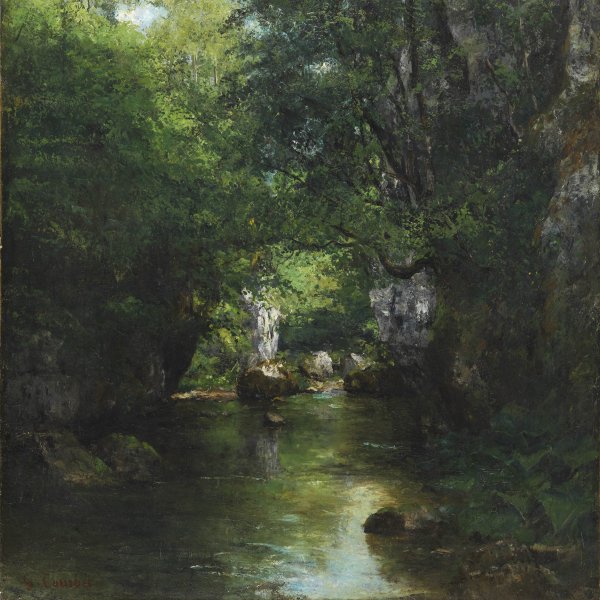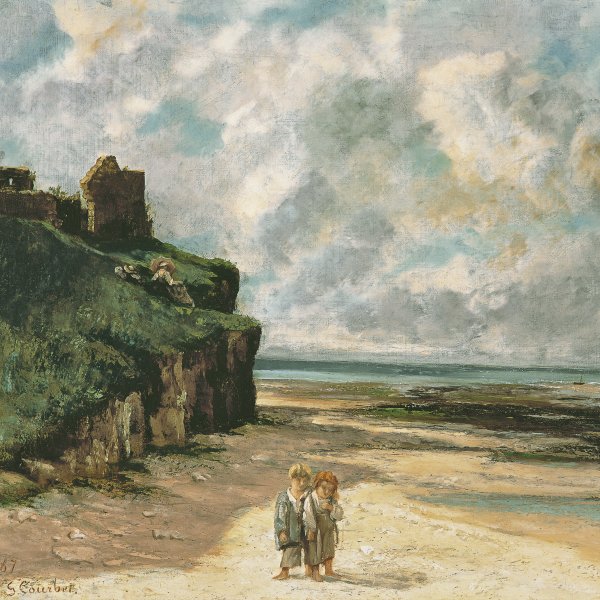Gustave Courbet
Ornans, 1819-La Tour-de-Peilz, 1877
Born in the Franche Compté to a family of landowners, Gustave Courbet was brought up on the principles of Voltaire and the Republic. In 1839 he moved to Paris to read law, but soon changed his mind and pursued a career in art instead. In the French capital he studied the works of the Great Masters in the Louvre and frequented the intellectual bohemia. The three works he showed at the Salon of 1851, Stonebreakers, 1849 (destroyed in 1945 in Dresden, Galerie Neue Meister), Burial at Ornans, 1849–50 (Paris, Musée d’Orsay) and Peasants of Flagey, 1850 (Besançon, Musée des Beaux Arts et d’Archéologie), attested to the consolidation of his realistic style and caused a powerful impact on the public, as it was the first time that common folk had been raised to the category of art.
Following Napoleon III’s coup d’état ushering in a new absolutist period that marked a return to conservatism in official tastes, Courbet’s works were rejected by the Salon of 1855.When his ambitious work The Artist’s Studio: A Real Allegory, 1854–55 (París, Musée d’Orsay) was rejected, Courbet made a public display of his rebellious streak and staged an unprecedented event: he exhibited his works near the official Salon in a pavilion of his own that went by the name of Realism. To mark this experience, which he would repeat in 1867 with Manet, the artist wrote a manifesto setting out his artistic ideas. Courbet believed that art should spring from the objective observation of life and advocated an anti-classical, anti-romantic, anti-academic, progressive and social brand of Realism.
Halfway through the 1850s, Courbet paid less attention to social themes and embarked on a period in which he mainly depicted landscapes and hunt scenes, as well as painting many portraits and nudes. His native region of Franche Compté became his chief source of inspiration. Years later, the again politically active Courbet took part in the Paris Commune which was established in 1871 following France’s defeat in the Franco-Prussian war. On being appointed as president of the federation of artists responsible for the conservation of Paris’s artistic heritage, he abolished the École des Beaux-Arts and all the medals awarded by the Salon, although he kept the jury. During his term in office the column of the Place Vendôme, erected not long earlier to commemorate Napoleon’s victories, was destroyed and Courbet was accused of being the main instigator. In 1873, after spending six months behind bars and being made to pay for its reconstruction, the artist moved to Switzerland, where he spent the last years of his life in exile.
Following Napoleon III’s coup d’état ushering in a new absolutist period that marked a return to conservatism in official tastes, Courbet’s works were rejected by the Salon of 1855.When his ambitious work The Artist’s Studio: A Real Allegory, 1854–55 (París, Musée d’Orsay) was rejected, Courbet made a public display of his rebellious streak and staged an unprecedented event: he exhibited his works near the official Salon in a pavilion of his own that went by the name of Realism. To mark this experience, which he would repeat in 1867 with Manet, the artist wrote a manifesto setting out his artistic ideas. Courbet believed that art should spring from the objective observation of life and advocated an anti-classical, anti-romantic, anti-academic, progressive and social brand of Realism.
Halfway through the 1850s, Courbet paid less attention to social themes and embarked on a period in which he mainly depicted landscapes and hunt scenes, as well as painting many portraits and nudes. His native region of Franche Compté became his chief source of inspiration. Years later, the again politically active Courbet took part in the Paris Commune which was established in 1871 following France’s defeat in the Franco-Prussian war. On being appointed as president of the federation of artists responsible for the conservation of Paris’s artistic heritage, he abolished the École des Beaux-Arts and all the medals awarded by the Salon, although he kept the jury. During his term in office the column of the Place Vendôme, erected not long earlier to commemorate Napoleon’s victories, was destroyed and Courbet was accused of being the main instigator. In 1873, after spending six months behind bars and being made to pay for its reconstruction, the artist moved to Switzerland, where he spent the last years of his life in exile.






